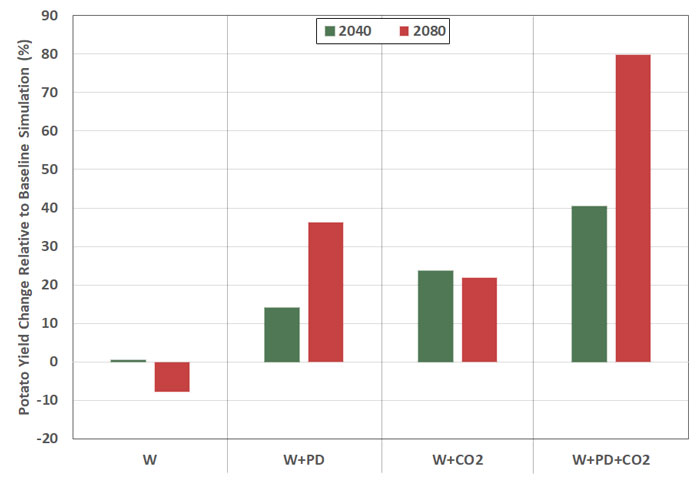| Tweet | Follow @co2science |
Paper Reviewed
Kim, Y.-U. and Lee, B.-W. 2020. Earlier planting offsets the adverse effect of global warming on spring potato in South Korea. Science of the Total Environment 742: 140667, doi.org/10.1016/j.scitotenv.2020.140667.
Climate alarmists frequently claim that any future yield increases caused by the aerial fertilization effect of atmospheric CO2 will be offset by stress-inducing influences caused by rising temperatures. However, as we have long reported, the optimum temperature for plant photosynthesis tends to rise with increasing atmospheric CO2 and counter this effect What is more, elevated CO2 can induce other physiological changes in plants to help cope with and even fully ameliorate temperature stress (see, for example, the many reviews we have posted on this topic under the heading Interactive Effects of CO2 and Temperature on Plant Growth on our website).
Beyond such physiological changes induced by rising CO2, there are additional reasons to suggest future crop yields will continue to rise in the years and decades ahead despite predicted changes in climate. To name but a few, most predictions of future yield losses are based on worse-case scenarios of temperature and CO2 rise that make them highly unlikely of ever occurring. Other predictions fail to include adaptation as a solution to combat climate change, ignoring, for example, a farmer's ability to (1) select cultivars that respond well under predicted environmental stresses and constraints, (2) alter the planting and harvest dates, or to (3) take advantage of the use of irrigation and fertilizers. When these and other factors are included, predictions of growing crop losses give way to estimates of widespread gains.
Consider in this regard the recent work of Kim and Lee (2020), two Korean scientists who examined spring potato crop yield projections for Korea in 2040 and 2080 based on the worse-case RCP8.5 global warming scenario, which projects atmospheric CO2 and temperature increases of 137 ppm and 1.7 °C in this region by 2040 and 426 ppm and 4.2 °C by 2080. Noting that two prior studies "provided pessimistic forecasts for the potato yield in South Korea," which pessimism they opined was likely due to coarse model resolution and/or a failure to allow for farmer adaptation in management practices, Kim and Lee set out to perform their own analysis using simulation results from five finer-scaled regional climate models, while also allowing for human adaptation in potato planting date. The results of their study are presented in Figure 1 below.
As seen there, when the potato yield was influenced by the worse-case scenario warming only, yields experienced no change by 2040, but decreased by 7.7% in 2080 (relative to the present). When planting date was added as an adaptive measure to the model that would allow for earlier planting under the rising temperatures, potato yields were found to increase by 14% and 36% in 2040 and 2080, respectively, fully ameliorating the future yield stagnation and loss predicted at these times in the warming-only scenario.
Similar results were obtained when the growth-enhancing effects of CO2 fertilization were added into the mix. When combined with the worse-case warming, this scenario resulted in projected potato yield increases of 24% in 2040 and 22% in 2080. And when all three factors were included in the model runs (warming, CO2, and planting date adjustment), things got really good -- projected potato yields rose 41% in 2040 and by a whopping 80% in 2080!
In commenting on their findings, Kim and Lee state the obvious, that a "highly optimistic view of the spring potato production in South Korea [is obtained]" when fine-scale models incorporate realistic adaptive strategies into their projections. Here at CO2 Science, given as much (and more!), we remain highly enthusiastic about the growth-enhancing, water-saving and stress-ameliorating benefits of CO2 fertilization on not just future crop yields, but for the unmanaged portions of the terrestrial biosphere as well.

Figure 1. Percent change in potato yield (relative to the present baseline) for South Korea in response to predicted warming temperatures (W), earlier planting dates (PD) and rising atmospheric CO2 concentrations (CO2). The results are averaged from simulations of five regional climate models using a predicted worse-case scenario (RCP8.5) of a future temperature and CO2 rise of 1.7 °C and 137 ppm in 2040, respectively, and 4.2 °C and 426 ppm in 2080. Data source: Kim and Lee (2020).




